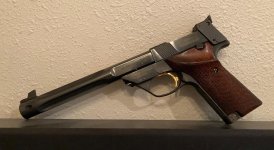Have 6 HS pistols myself. Favorite .22 semi-auto maker, amazingly accurate. Here's an interesting and mostly unknown story behind the founding of High Standard:
On April 19, 1879 Carl Gustave Swebilius was born in Vingaker, Sweden. He was one of five children of the town watch maker. He grew up working with his father and learning his love of precision machinery. At age 18, Gus immigrated to the United States and lived with his eldest sister in New Haven, Connecticut.
His first job in the U.S. was making barrels for Marlin firearms company. He was quickly promoted to foreman of that department. He continued to attract notice and was promoted to the tool room. After three years, he was transferred to gun design where he was working at the outbreak of World War I.
While there he modified the Browning .30 caliber machine gun for use on aircraft by lightening it from 35 to around 19 pounds and increasing the rate for fire from 400 to 900 rounds per minute. He finished that task in less than a month.
Swebilius was the first American to perfect the cam system sending bullets between spinning propeller blades and the first to synchronize a gas operated machine gun. His design was used on propeller aircraft through World War Two.
Major George Chinn, author of the classic tome
The Machine Gun, recognizes Swebilius as second only to John Browning in early design of machine guns. Coincidentally, Swebilius worked with Browning during World War I. Following World War I, Swebilius worked as chief designer at Marlin and then at Winchester until 1939.
Swebilius worked not only at Marlin and Winchester, but also on a side venture producing high quality barrels and barrel drilling equipment. In 1932, Swebilius, Gustave Beck (a partner in the barrel drilling business) and three other investors bought the defunct Hartford Arms company lock, stock, barrel and manufacturing tools for $800.
The deal included enough partially assembled pistols and parts to complete around 800 pistols. George Wilson, Sr. was hired as foreman to assemble the pistols. Swebilius sold them to Galefs Hardware and Sporting Goods stores. They made enough money on the deal to pay off the note and they had the equipment to produce more pistols. This was the way Swebilius did business.
After some modifications by Wilson, the Hartford semiautomatic became the High Standard Model B starting with serial number 5000. The business was successful. Swebilius hired new Swedish immigrants whenever possible. When the United States entered World War II business skyrocketed. Initially the military used the model B for a machine gun sub-caliber firing device.
A complete HS story including the above follows here:
https://smallarmsreview.com/high-standard-guns-of-world-war-ii/






